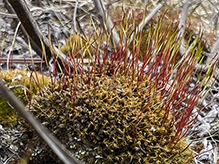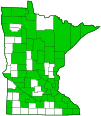redshank
(Ceratodon purpureus)
Conservation • Description • Habitat • Ecology • Use • Distribution • Taxonomy
Conservation Status |
|
|||||||
| IUCN Red List | not listed |
|||||||
| NatureServe | NNR - Unranked SNR - Unranked |
|||||||
| Minnesota | not listed |
|||||||
Description |
||
Redshank is a very widespread, very common, mat-forming moss. It occurs worldwide, probably in every country in the northern and southern temperate zones but is replaced in the tropical zone by closely related species. In North America it occurs in every U.S. state and Canadian province, but it is most common east of the Great Plains and west of the Rocky Mountains. It is common in Minnesota. It is found in a wide variety of habitats and is often found on disturbed sites. It grows under full sun or light shade, in moist or moderately moist areas, in sandy, gravelly, or clay soils. It frequently colonizes areas following wildfires or controlled burns. It often occurs in industrial environments because it is able to tolerate high pollution levels. In urban areas it is found growing through sidewalk cracks, on old roofs, and on exposed bare ground. Redshank has an upright growth habit (acrocarp). It usually forms an open or dense tuft, sometimes a cushion, composed of both fertile and non-fertile shoots. The tuft or cushion may be green, dark green, brownish-green, light green, or yellowish-green, and is often tinged with purple or reddish-brown. The stems are erect and usually ⅜″ to 1 3⁄16″ (1 to 3 mm) long. In shaded areas they can be 2¾″ to 3⅛″ (7 to 8 cm) long. They are usually unbranched, sometimes forked at the tip. They are densely leafy and are usually darker at the base. The upper 3⁄16″ (5 mm) is the current year’s growth. Fibrous filaments (rhizoids) at the base adhere the stem to the substrate, usually soil. The leaves are crowded, stalkless, spreading to ascending, and slightly arched. They are lance-shaped, egg lance-shaped, or triangular lance-shaped, and 1⁄64″ to ⅛″ (0.35 to 2.8 mm) long. When moist they are flat and spread outward in all directions. When they dry out, they become folded or twisted. The leaf blade consists of a wide midrib (costa) with a flat portion (lamina) on each side. The costa is ridged (keeled) on the underside and is more than one third the total width of the blade. The lamina is translucent and folds over the costa on each side almost to the leaf tip. The costa is darker green and more opaque. It sometimes continues beyond the blade as a long smooth awn. The stem, leaves, and root-like structures (rhizoids), together are the gametophyte phase of the moss life cycle. Male reproductive structures (antheridia) and female reproductive structures (archegonia) are borne on separate plants at the tip of the stem. The fertilized egg produces a spore-producing structure (sporophyte). The sporophyte consists of a foot, which attaches the sporophyte to the gametophyte, a long stalk (seta), and a capsule. At maturity, the seta is stout, ⅜″ to 1 3⁄16″ (1 to 3 cm) long, and variable in color with shades of yellowish-green to deep red. When immature, the capsule is round and green. At maturity the capsule is dark red and 1⁄16″ to 3⁄32″ (2.0 to 2.5 mm) long. There is a slight bulge (struma) on one side at the base of the capsule. At the end of the capsule there is an opening that is covered with a membranous hood (operculum). The operculum is cone-shaped and straight. The entire capsule is covered with a hood (calyptra). The calyptra is hairless and has a long extension (beak) that is usually held at an angle. As it matures, the capsule becomes slightly curved and develops a ring around the opening (annulus). At maturity the calyptra falls off. The annulus forces the operculum to drop off exposing the capsule opening with a ring of 16 teeth. The spores are dispersed by wind. |
||
Growth Form |
||
Acrocarp |
||
Height |
||
¾″ to 2⅜″ (2 to 6 cm) including the sporophyte |
||
Similar Species |
||
Habitat |
||
Moist or moderately moist. Disturbed areas. Full sun or light shade. Sandy, gravelly, or clay soils. |
||
Ecology |
||
|
||
Use |
||
|
||
Distribution |
||||
|
Sources Janssens, Joannes A., and The Minnesota County Biological Survey, Minnesota Department of Natural Resources, State of Minnesota. County Atlas of Minnesota Mosses. May, 2000. |
|||
| 6/7/2022 | ||||
Nativity |
||||
Native |
||||
Occurrence |
||||
Very widespread and very common |
||||
Taxonomy |
|||
| Kingdom | Plantae (Plants) | ||
| Division | Bryophyta (Mosses) | ||
| Subdivision | Bryophytina (Moss) | ||
| Class | Bryopsida (Joint-toothed Mosses) | ||
| Subclass | Dicranidae | ||
Order |
Dicranales | ||
Family |
Ditrichaceae | ||
Genus |
Ceratodon | ||
Subordinate Taxa |
|||
redshank (Ceratodon purpureus convolutus) redshank (Ceratodon purpureus purpureus) redshank (Ceratodon purpureus stenocarpus) round-leaved ceratodon moss (Ceratodon purpureus rotundifolius) |
|||
Synonyms |
|||
Ceratodon dimorphus Ceratodon purpurascens Dicranum purpureum Mielichhoferia recurvifolia |
|||
Common Names |
|||
ceratodon moss fire moss purple forkmoss purple horn toothed moss purple horn-toothed moss purple moss redshank |
|||
Glossary
Acrocarp
A moss that grows in cushions or tufts; has an upright growth habit; is usually unbranched or sparingly forked; and has the female sporophytes borne at the tips of stems and branches. Adj.: acrocarpous.
Annulus
On mosses: a ring of cells around the capsule opening beneath the operculum.
Beak
In plants: A comparatively short and stout, narrow or prolonged tip on a thickened organ, as on some fruits and seeds. In insects: The protruding, tubular mouthpart of a sucking insect.
Calyptra
On mosses: A thin cap that covers and protects the capsule and operculum and drops off at maturity.
Costa
On ferns: The central axis of a pinna, to which pinnules are attached. On mosses: the central axis (midvein) of a leaf. On insects: The vein on the leading edge of the forewing.
Keeled
Folded, as in a grass blade, or with a raised ridge, as in a grass sheath; like the keel of a boat.
Operculum
On mosses: A lid or cover that covers the opening of a capsule and detatches at maturity. On snails: The horny or calcareous door-like structure that seals opening of the shell. On fishes: A bony flap on the rear side of the head that protects the gills.
Rhizoid
A filament arising from the lower stem of a moss, liverwort, or alga that anchors it to a substrate.
Seta
A stiff, hair-like process on the outer surface of an organism. In Lepidoptera: A usually rigid bristle- or hair-like outgrowth used to sense touch. In mosses: The stalk supporting a spore-bearing capsule and supplying it with nutrients. Plural: setae. Adjective: setose.
Visitor Photos |
|||||
Share your photo of this plant. |
|||||
| This button not working for you? Simply email us at info@MinnesotaSeasons.com. Attach one or more photos and, if you like, a caption. |
|||||
Nancy Falkum |
|||||
 |
|||||
MinnesotaSeasons.com Photos |
|||||
|
|||||

Slideshows |
||

Visitor Videos |
|||
Share your video of this plant. |
|||
| This button not working for you? Simply email us at info@MinnesotaSeasons.com. Attach a video, a YouTube link, or a cloud storage link. |
|||
Other Videos |
|||
| Spore dispersal of a moss, Ceratodon purpureus. Masaki Shimamura |
|||
About
Apr 16, 2017 Spore dispersal of a moss, Ceratodon purpureus. |
|||
| Fire Moss: an Understudied Phenomenon and Potential Tool for Post-Fire Rehabilitation By: Henry S. Grover |
|||
About
Dec 7, 2020 Abstract: With wildfires increasing in extent and severity in the Southwestern USA, practitioners need new tools to rehabilitate recently burned ecosystems. Fire mosses consist of three species, Ceratodon purpureus (Redshank), Funaria hygrometrica (Cord moss), and Bryum argenteum (Silvergreen moss). Fire mosses can colonize burned landscapes rapidly and aggregate soils but have not been widely studied. This dissertation explores the potential utility of fire moss as a post-fire ecosystem rehabilitation tool. To better understand where and how quickly mosses colonize after fire, we conducted a natural survey of moss colonization and function on 10 severely burned areas in the southwestern USA. We tested 11 landscape scale predictors of fire moss cover and found that it is most strongly influenced by equinox insolation, pre-fire vegetation type, pre-fire soil organic carbon, and time since fire. We also found that, when compared to bare soils, fire mosses increase infiltration by 50% on average and soil stability by more than 100%. A major step in developing a new plant materials rehabilitation technique is overcoming propagule limitations using ex situ cultivation. We cultivated fire moss gametophyte fragments in the greenhouse allowing us to grow vegetative propagules with control over atmospheric, edaphic, and hydrologic conditions. In this experiment, we grew fire mosses using an easily scalable technique and commercially available materials. We found that fire moss achieved high cover in 2 months when grown on organic substrate with constant wicking hydration and a protective shade covering, but growth was not favored by addition of burned materials. We demonstrated repeated success growing these species in the greenhouse at increased scales and fine-tuned harvesting techniques to increase productivity. To test this greenhouse grown moss in the field we conducted three sequential experiments using knowledge gained from previous experiments to fine tune fire moss delivery methods. The first two experiments began one week after full containment of a wildfire in a Pinus ponderosa forest of Arizona. First, we added disaggregated (passed through a 2mm sieve) moss tissue to burned soil surfaces, which was immediately collected by ants. In response to the unexpected herbivory pressure, we added two preparations designed to reduce predation: moss rolled into pellets using diatomaceous earth and moss ground to a powder. Pelletization increased Bryum argenteum cover and the number of distinct moss colonies when compared to untreated control plots, although cover remained low (1%). The third experiment took place in a mixed conifer forest of New Mexico, USA. Sieved moss, pelletized moss, and pelletized moss at a high (5×) application rate were added to a burned forest, four months after full containment. The high pelletized treatment increased cover to 10% after 1.5 years, but treatments largely converged afterward. At both sites, an exceptional drought during the winter of 2017-18 likely dampened moss establishment. Our results indicate that fire mosses are important colonizers after wildfire, which should be considered when making land management decisions and studied further for their utility as a rehabilitation tool. |
|||
| Tiny Arthropods Helping Mosses! Brilliant Botany |
|||
About
Aug 28, 2013 Support Brilliant Botany on Patreon: http://www.patreon.com/brilliantbotany A study published in Nature last year showed that the moss Ceradon purpureus produces sex-specific volatile compounds to attract arthropods, which help with fertilization. Source: Rosenstiel, Todd N. et al. "Sex-specific volatile compounds influence microarthropod- mediated fertilization of moss." Nature. 489.7416 (2012): 431-433. Electronic. http://www.brilliantbotany.com Twitter: @brilliantbotany Have a question about the video, or anything botany-related? Post it in the comments and I'll answer it in a future video. Thumbnail image: https://commons.wikimedia.org/wiki/File:Ceratodon_purpureus_%28g,_144705-474825%29_2259.JPG |
|||

Created: 6/7/2022
Last Updated:


